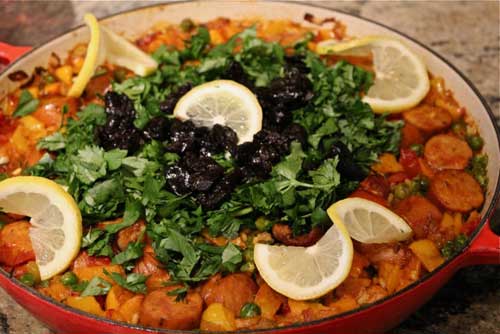.jpg)
My mother grew up in North Africa. Casablanca, to be precise. This was not by choice; during the Third Reich, Morocco was one of the few open countries for fleeing European Jewry. My mother’s Morocco was not the romantic Bogart/ Bergman variety, nor the National Geographic glossies of camels dressed in colorful textiles, sauntering across the desert. It was diverse, to say the least. She lived with a Jewish family that had, on one side, fled to Morocco during the Spanish Inquisition and, on the other, escaped to North Africa during the Russian Revolution. The household language and culture was French, as was the region. My point? I grew up with assorted cultural traditions, from Arab to Sephardic to Ashkenazi, to Russian, all coming across through a Spanish and French filter.
And so, my Paella a la Diaspora:
What you will need to serve 6:
Paella pan or wide, 2-3 inch deep sauté pan.
Virgin olive oil
1 package of Neshama brand or other Kosher Andouille sausage, cut into ½ inch slices (Rabbinical Council of California, Star K)
5 skinless and boneless chicken thighs, cut in half. Try to avoid frozen chicken. The freezing process changes the texture enormously.
2 cups sweet onion, chopped
2 cloves of garlic, finely chopped
2 cups tomatoes, chopped. August is ideal for sweet, fresh tomatoes.
2 cups red bell pepper, yellow bell pepper, chopped
5-7 cups chicken stock. Have this ready and hot in a pot on the stove
Freshly ground pepper.
1 teaspoon cumin total. Half for seasoning the chicken, half for adding to the pan later.
1 cup fresh cooked or frozen peas
8 strands saffron
2 T fresh thyme leaves
2 ½ T sweet Andalusian paprika
1 bay leaf
1 cup chopped fresh cilantro
1 cup fresh chopped parsley
½ cup pitted Moroccan olives
Six thin slices of lemon
1 ½ cups hard, dry rice, ideally Spanish Calasparra, which is traditional paella rice. In a pinch, you can use Arborio rice, the type used to make risotto. This dish requires a rice that soaks up a great deal of stock.
If you have a fine extra virgin Spanish olive oil, drizzle it over the entire finished dish. A top-notch, fragrant, fruity Spanish cold-pressed olive oil will elevate the dish to a delicious new height.
Notes on hot pepper and salt: If the sausage you select is not spicy, you can add ½ teaspoon of cayenne pepper or more to taste.
Regarding salt: the stock probably has enough salt and, in the cooking-down process, there will be little, if any, need for additional salt. Salt to taste if necessary.
Put halved chicken thighs in a bowl. Add half clove of finely chopped garlic, about ½ teaspoon freshly ground pepper, ½ teaspoon cumin, ½ teaspoon paprika. Drizzle with olive oil and toss to coat.
While the chicken is taking on the seasoning, chop the peppers, onions, measure out the rice, pull the leaves off the thyme, slice the sausage, rinse and pat dry the cilantro and the parsley.
Heat the pan and add olive oil. Brown the chicken thoroughly on each side, so that it cooks through. Put the chicken pieces in a bowl and pour all the juices from the pan onto the pieces in the bowl.
Heat pan again. Add olive oil. Sauté onions until carmelized. Add the peppers and tomatoes. Sauté until soft.
Add freshly ground pepper, ½ teaspoon cumin, all the saffron threads, and the remaining chopped garlic. Sauté for several minutes over medium heat . Never let garlic burn.
Add the chicken and the juices. Add the sausage pieces and blend to coat the meats.
Add 2 tablespoons sweet Andalusian pepper. Blend it in.
Add to the pan four cups of the stock, the fresh thyme leaves and the bay leaf. Stir to blend.
Stir in the peas.
Simmer, uncovered, for five minutes.
Add the rice, stir to blend and lightly pat down so all the ingredients and the rice are just covered with stock. Simmer on medium heat, uncovered. DO NOT STIR! If you stir, you will activate and distribute the starches in the rice. Stirring is what makes risotto creamy. You want this rice to be firm, not creamy.
Add more hot stock as the liquid evaporates before the rice is done. Cooking time should be about 25 minutes. You can test a piece of rice from the top of the pan and see if it is firm and done.
While the paella is cooking, chop the cilantro and parsley together. Right before serving, garnish with cilantro and parsley. Toss the pitted Moroccan olives on top. Garnish with lemon slices.
Bon appetit! Besseha!!
Buen apetito! Enjoy!
By Lisa Reitman Dobi











